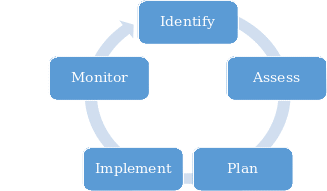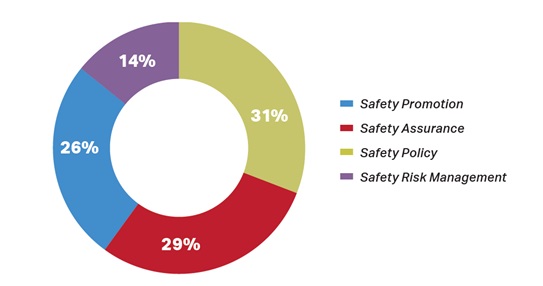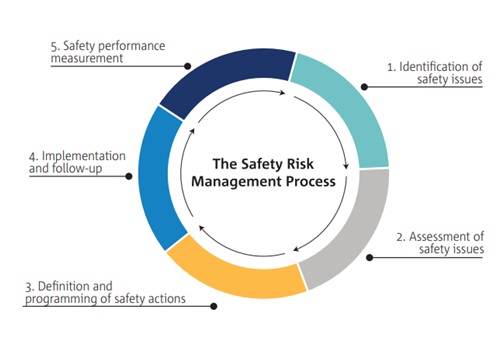Introduction
Civil aviation has outstanding strategic importance today. Its ability to support the globalization of the world, foster international relations, and provide clients with the desired levels of comfort contribute to the high speed of the sector’s evolution and it’s becoming the basis for the future rise of society (Stolzer and Gogila, 2016). However, the increasing role also means that the number of passengers grows and aviation has to work in a complex environment (Cusick, Cortes and Rodrigues, 2017). Under these conditions, the safety of passengers and flights becomes a major concern for civil aviation. Correctly realizing the fundamental role of this aspect, Ireland has its one strategic position regarding the creation of a safe environment in aviation, its support, regulation, and mitigation of risk factors. The effectiveness of the current approach to security and the choice of best practices is vital for positive outcomes and the ability to protect passengers and specialists involved in the functioning of the sphere. For this reason, the presented paper is devoted to the in-depth analysis of the current strategic position of Ireland concerning civil aviation safety and its choice of methods to continue the evolution of the sphere.
Objectives
The case study on the strategic actions aimed at improving aviation safety in Ireland is selected as the basis for the paper. There are several objectives that are introduced to investigate the offered situation comprehensively. They include
- To investigate the current strategic position of Ireland regarding aviation safety
- To discuss the major concerns and areas of improvement
- To outline how the major deficiencies are managed in terms of the plan
- To evaluate the current ICAO, IATA, EASA approaches to safety management
- To determine how these methods can be applied to the situation in Ireland
- To conclude about the current state of civil aviation in the country
In such a way, the given objectives presuppose the in-depth investigation of the case and its critical discussion to highlight the most important areas and create the basis for the discussion and conclusions linked to aviation safety in Ireland.
Strategic Position and Its Analysis
The Irish Aviation Authority Safety Regulation Division (IAA) offers a State Plan for Aviation Safety (SPAS), which can be viewed as the major document demonstrating the current position of the state regarding safety concerns and the protection of passengers, aircraft, and specialists during the flight and other operations. The IAA safety regulation division offers a safety management system that rests on the five major concerns:

It means that the current methodology presupposes the effective identification of existing hazards, assessment of risks to prioritize actions, planning to address outlined problems, implementation of selected strategies, and evaluation and monitoring of results (IAA, 2019a). The effectiveness of the methods rests on the correct data collection and potent investigation tools that help to analyze problematic areas and create the basis for discussion and the creation of new strategies.
Cooperation with International Agencies
One of the basic pillars of the strategy employed by IAA is the cooperation with the international agencies such as International Civil Aviation Organization (ICAO), International Air Transport Association (IATA), and European Union Aviation Safety Agency (EASA) to share knowledge and engage in collaborative efforts to create secure environments and protect individuals. IAA’s approach is aligned with the major goals and objectives of the Global Aviation Safety Plan (GASP) and the European Plan for Aviation Safety (EPAS) to ensure that all recommended measures are implemented in Ireland and help to minimise risks and manage them effectively (IAA, 2019a). In such a way, IAA contributes both to the global and state safety management efforts by its participation in these bodies and regulation of the national civil aviation sector (IAA, 2019a). At the same time, the agency benefits from the information provided by the other EU Members States about security concerns and acquires an opportunity to create effective responses to new threats. Additionally, the consistency with GASP 2020-2022 and its six major goals (see Appendix 1) guarantees that Ireland will remain capable of struggling against new hazards and protecting passengers from them.
Observation of Strategic Objectives
IAA’s strategic position also presupposes the formulation of its own objectives that are vital for the effective risk management and creation of a safe environment (see Appendix 2). The central aspects of the framework created by these goals presuppose enablement of safe, secure, and sustainable civil aviation system in Ireland by means of appropriate regulations, effective safety oversight, observation of the international standards, and implementation of risk-based and performance-based practices (IAA, 2019a). In such a way, safety promotion, creation of safety culture, and encouragement of safety performance acquire the top priority as the central tasks that are given specific attention by IAA (2019a). The objectives are designed with the primary goal to encompass all factors and aspects that might have a negative impact on civil aviation functioning and ensure that specialists remain resilient to new hazards of possible attacks.
Risks and Challenges Management
Correctly realising the high pace of the sphere’s evolution, and the tendency towards the emergence of new factors affecting civil aviation, IAA devotes much effort to challenges and risk management as a part of its current strategic position. Thus, the SPAS includes a list of challenges that will drive the evolution safety approach in the next several years and precondition the implementation of specific methods. These include the promotion of the positive safety culture, assessment of evolving needs of the industry, provision of adequate resources, and maintenance of the world-class security system (IAA, 2019a). Moreover, IAA outlines the critical elements of the Irish civil aviation and safety oversight system with the primary goal to focus on their development as the way to resist emerging risks and manage them effectively. These elements are:
- Structure and policy
- Regulatory Change Management
- Regulatory Oversight
- Human Resources
- Facilities and Equipment
- Safety Management
- Safety Promotion
- Performance monitoring
- Operational Risks (IAA, 2019a).
Achievement of progress in these spheres is a part of Irish strategic position regarding civil aviation and preconditions the evolution of the field in the next several years.
Systematic and Specific Risk Management
As a part of its strategic vision IAA, also outlines a list of risks peculiar to civil aviation at the moment and impacting Ireland. They fall into two categories, such as systematic and specific risks. Their appropriate management becomes a fundamental aspect of the existing approach to security as it can guarantee the absence of incidents and safety to passengers. The group of systematic risks includes COVID-19, Brexit, use of Drones, rotorcraft operations, aircraft maintenance, operational models, and parallel runways (IAA, 2019a). Specific risk areas presuppose loss of control, mid-air collision, controlled flight into terrain, runway safety, aircraft environment, bird strikes, and ground operations (IAA, 2019a). These risks can be viewed as the most topical and relevant factors affecting the functioning of civil aviation globally, which means that the increased attention to their management can help to attain better outcomes and protect passengers, crew, and the ground personnel.
Improvement
Finally, IAA is focused on the continuous improvement of civil aviation functioning by devoting more resources and implementing new strategies that will help to attain higher levels of effectiveness. At the moment, the SPAS offers the following distribution of actions concerning the main SSP pillars:

In such a way, safety policy and safety assurance are given the most attention due to their importance and impact on outcomes. However, other areas are also given attention, and there are multiple strategies aimed at the improvement of these sectors by providing appropriate resources and recommendations on further evolution.
Addressing the Current Deficiencies
In such a way, the existing strategic plan can be viewed as a potent tool to resist threats peculiar to civil aviation sphere today and guarantee safety to passengers. The high practical utility of the plan and its ability to create the basis for future improvements can be evidenced by using data for Safety Performance Review 2019. The report states that the situation in the civil aviation sector of Ireland remains positive; however, in the past five years, 22 serious incidents in different safety areas happened: 11 mid-air collisions, nine runaway incursions, one runway excursion, and one controlled flight into terrain (IAA, 2019b). Additionally, there were three cases of turbulence encounters and aircraft upset during flights (IAA, 2019b). In such a way, the causes for the given accidents and their analysis demonstrate the need for the improvements in these areas to minimise the risk of new situations of this sort and protect all actors involved in the process.
Analysing this information in terms of the current strategic position of IAA and the SPAS, it is possible to state that the major deficiencies highlight in Safety Performance Review, such as ground handling and operations, collision, runaway incursion, system failure, mid-air collision, turbulence encounter, and medical safety, are adequately addressed in the 4-year strategic plan. As stated above, it presupposes the increased attention to specific and systematic risks and their correct management. The first category includes mid-air collision, controlled flight into terrain, runway safety, aircraft environment, bird strikes, and ground operation, or the areas that are associated with the highest number of accidents (IAA, 2019b). In such a way, correctly realising the need for the improved and safe environment and effective security management, IAA introduces the plan which encompasses the essential areas and helps to avoid new problems in the future.
However, speaking about the SPAS and the exiting strategic framework, it is necessary to outline some possible areas for the improvements. First of all, although IAA recognises the growing importance of cybersecurity, it is not addressed in the provided plan, which can be viewed as its serious drawback. The use of technologies and innovative applications to increase the effectiveness and reduce costs preconditions the emergence of loopholes in security systems which can be used by malefactors to cause harm and precondition system failure (IAA, 2019a). For this reason, there is a significant need for the improved security measures aimed at the mitigation of this risk factor and creation of a safe cyber environment to protect all participants of the key processes in civil aviation.
Strategic Choices & Best Practices
The importance of safety concerns is evidenced by the fact that international agencies functioning in the sphere are also focused on the protection of individuals and resisting threats that emerge today. For instance, ICAO (2020) views safety as the highest priority when introducing its strategic objectives. It is focused on the continuous enhancement of global civil aviation safety by considering the context of growing passenger and cargo movements, along with the demand to address efficiency and environmental sustainability (ICAO, 2017). To achieve the given purpose, ICAO offers the Global Aviation Safety Plan (GASP) with safety enhancement initiatives (SEIs) the five main priorities, such as to enhance risk awareness, to develop security culture, to improve technologies, to develop quality assurance, and to increase cooperation and support (ICAO, 2019). These guidelines are introduced to guarantee safety to all actors and help local agencies to use practices that cultivate positive outcomes.
IATA also supports the development of safety practices and frameworks. First of all, it supports the implementation of safety management systems across different nations and organisations. For instance, the idea of Global Aviation Data Management integrating all sources of operational data from different strategies helps to meet the current objectives and manage emerging risks more effectively (IATA, no date). Additionally, both IATA and ICAO are focused on the implementation of a fill risk-based approach as the way to evaluate existing threats and ensure that there are appropriate strategies and measures to reduce their negative impact and attain improved outcomes.
EASA introduces its own paradigm for safety risk management consisting of several stages:

In such a way, the identification of threats, their analysis, definition, and development of appropriate solutions are viewed as the major concerns of the European Plan for Aviation Safety (EPAS). The given document outlines the framework for the systematic improvement by analysing data on accidents and incidents and offering it to different nations to eliminate the causes for the emergence of such risks and minimise the risks of new problematic issues (EASA, 2020). In such a way, the use of previous experiences combined with the scientific approach and research is expected to demonstrate outstanding results and contribute to the significant improvement if aviation safety management.
Civil Air Navigation Services Organization (CANSO) is another agency that views safety as a number one concern for civil aviation. In terms of the new challenges that emerge every day, CANSO (2018) offers the implementation of new technology, the appropriate use of resources, and innovative security systems as a method to enhance global safety performance. The organisation also aims at the provision of global leadership on safety management issues by offering its own training in air traffic management and emphasising the need for the elimination of threats by more effective analysis of risks and their mitigation (CANSO, 2018).
Irish Aviation Safety Plan and International Guidelines
Analysing the strategy offered by IAA as the way to attain better safety performance, and guidelines and best practices suggested by other agencies, it is possible to conclude that the SPAS adheres to the given framework. It can be justified by several factors. First of all, Ireland focuses on the necessity to cooperate with other European nations to achieve success and guarantee safety to all passengers. For this reason, it accepts the ideas of GASP 2020-2022 and the major SEIs offered by it. They are integrated into the plan for development and action provided by IAA and serve as the framework for the further improvement and effective risk mitigation.
Another factor proving the adherence to the best practices by IAA is its focus on the risk evaluation and assessment practices with the primary goal to attain improved outcomes and protect passengers and specialists from various threats. The SPAS acknowledges the need for better performance in the most important areas and views a risk-based approach as the way to move towards the desired goal. In accordance with ICAO or IATA’s recommendations, IAA devotes much attention to specific and systematic risks which serve as the major causes for incidents in the country. It means that the organisation is focused on collaboration with other nations in the sphere of aviation safety to attain improved results and avoid deterioration of the situation in the future.
Conclusion
Altogether, safety is the fundamental concern of civil aviation today as it helps to avoid accidents and protect people. IAA recognises this fact and moves towards the better levels of excellence by introducing new programs and guidelines that will assist airlines in minimising risks and managing them effectively. The SPAS outlines the goals for the next several years and ways to achieve them by devoting effort and resources to the central areas. IAA also adheres to the international guidelines offered by ICAO and IATA and views further collaboration with them as an effective strategy to guarantee success in the future.
Reference List
Civil Air Navigation Services Organisation (CANSO) (2018) Global air navigation services performance report 2018. Web.
Cusick, S., Cortes, A. and Rodrigues, C. (2017) Commercial aviation safety, 6th edn. London: McGraw Hill Education.
European Union Aviation Safety Agency (EASA) (2020) Annual safety review. Web.
Irish Aviation Authority (IAA) (2019a) State plan for aviation safety in Ireland. Web.
Irish Aviation Authority (IAA) (2019b) Review of aviation safety performance in Ireland. During 2019. Web.
International Air Transport Association (IATA) (no date) Safety report. Web.
International Civil Aviation Organization (ICAO) (2017) Aviation security manual, 10th edn. Montreal: International Civil Aviation Organization.
International Civil Aviation Organization (ICAO) (2019) Global aviation safety plan 2020-2022. Web.
International Civil Aviation Organization (ICAO) (2020) Safety report. Web.
Stolzer, A. and Gogila, J. (2016) Safety management systems in aviation, 2nd edn. London: Routldege.
Appendices
Appendix 1. The GASP 2020-2022 Main Goals
- Goal 1 is to achieve a continuous reduction of operational safety risks.
- Goal 2 calls for all States to strengthen their safety oversight capabilities.
- Goal 3 is also aimed at individual States and calls for the implementation of effective SSPs.
- Goal 4 calls for States to increase collaboration at the regional level to enhance safety.
- Goal 5 aims to expand the use of industry programmes.
- Goal 6 focuses on the need to ensure the appropriate infrastructure is available to support
(IAA, 2019a, p. 7)
Appendix 2. Strategic Safety Objectives
- To enable safe, secure and sustainable civil aviation system in Ireland through the provision of appropriate regulatory framework and operating rules and effective safety oversight.
- To continuously monitor and enhance the Irish safety oversight system to ensure it maintains it’s strong global ranking as the ICAO standards and civil aviation system continuously evolve.
- To enable safe, secure and sustainable civil aviation system in Ireland through effective safety management
- To provide legal certainty on the independence of the IAA safety regulatory functions from the air navigation services provision.
- To ensure that the operational risks are fully assessed and mitigated to reduce the risk of an accident or serious incident
- To enhance safety oversight through implementing risk-based and performance-based safety oversight
- To collaborate with regulatory authorities of affected EU Member States on safety oversight of organisations performing aviation activities across different EU States
- To support Irish civil aviation through effective safety promotion
- To ensure the IAA regulator has sufficient and appropriately qualified and competent staff to provide effective safety oversight and safety management
- To provide enhanced ability to derive and share safety intelligence, through development of advanced digitalisation processes, including business intelligence and big data capabilities.
- To ensure the safety performance of the Irish civil aviation system is appropriately monitored to verify that safety objectives are being achieved
- To encourage safety culture, safety reporting and management of safety through hazard identification and safety risk management
(IAA, 2019a, p. 87)